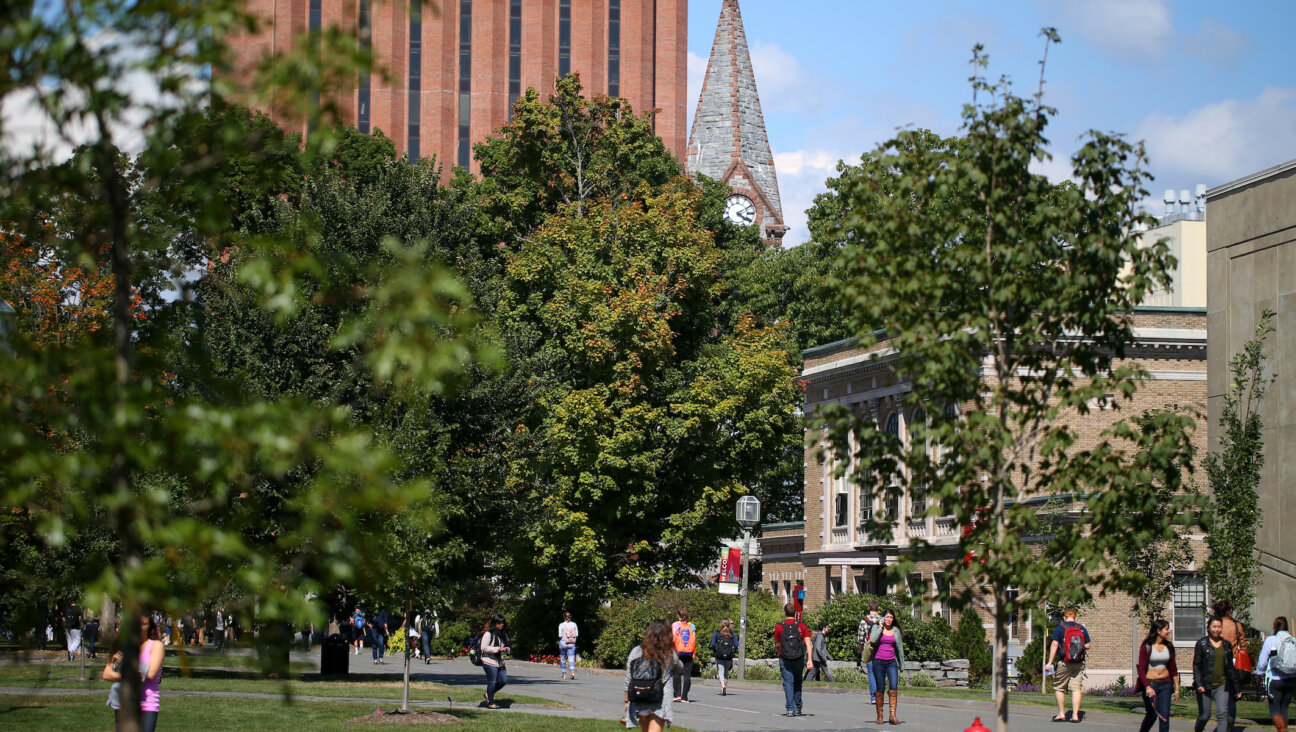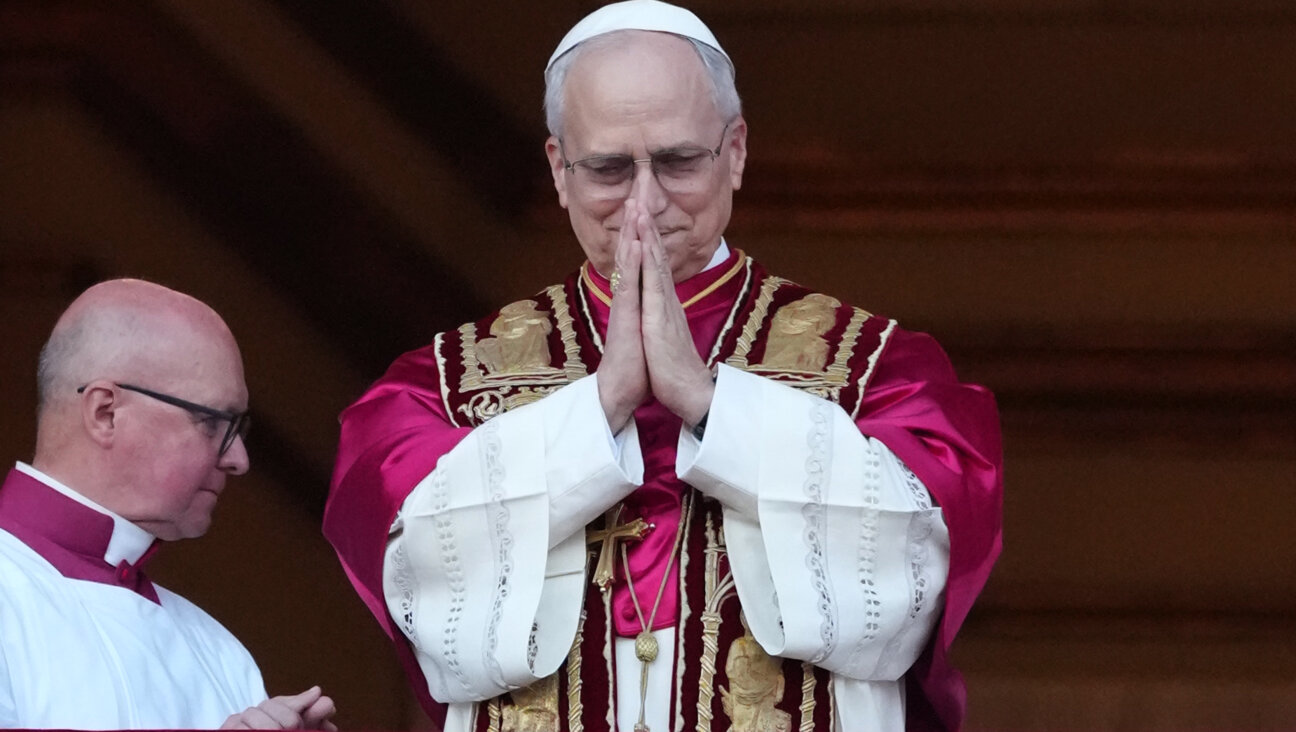At 95, the heroes of the Ghost Army relive the battles of WWII
This top-secret unit used inflatable tanks, planes and phony encampments to dupe the German army

A Dummy Tank Destroyer: One of the Ghost Army’s many inventive creations. Image by Ghost Army Legacy Project
Author’s note: June 6, 2019 is the 75th Anniversary of D-Day, when the Allied troops invaded Nazi-held Normandy to a decisive victor, signaling a power shift in the European theater. This previously-published story recounts the efforts of two veterans from a unique outfit deployed to aid the Allies in the pivotal days following the landings.
At 95, Bernard Bluestein and Seymour Nussenbaum like to keep busy.
Bluestein spends five days a week at Harper College in Palatine, Illinois, where he is in his third decade as an art student. Nussenbaum, a self-described “inveterate collector” now based in Monroe Township, New Jersey, is attempting to capture the history of the Jewish people through his collection of philately. His horde of stamps and postage includes an envelope sent by the first president of Israel, Chaim Weizmann; a postcard sent to Hadassah’s founder, Henrietta Szold, and countless other artifacts.
But the two men, longtime friends, are linked in another way. They are both former members of the 603rd Camouflage Engineers, the visual deception wing of the 23rd Headquarters Special Troops, the legendary “Ghost Army” that used inflatable tanks, planes and phony encampments to dupe the German Army during World War II.
The 23rd was formed in 1944, the brainchild of journalist Ralph Ingersoll and Col. Billy Harris, his boss in the “Special Plans” branch of the U.S. Army’s London Headquarters. The outfit numbered 1,100 men, including the 406th Combat Engineers, who handled security, and the 3132 Signal Service Company Special and Signal Company Special in charge of radio and audio deception. The troops’ 20 maneuvers, which included diversionary river crossings and the construction of fake supply harbors in the aftermath of the Normandy invasion, were inspired by similar tactics and equipment used by the British in the 1942 Battle of El Alamein, in Egypt.
Bluestein and Nussenbaum’s journey to this battalion began with their shared love of art and their reluctance to be involved in combat.
“Usually when you get inducted they throw you into the infantry, they give you the gun and they say, ‘Okay, go out there and shoot the enemy and let him shoot at you,’” Bluestein said from his home in Schaumburg, Illinois. “I wasn’t looking for that type of an activity.”
Halfway through his second year at the Cleveland Institute of Art, Bluestein saw a bulletin for an Army-sponsored camouflage course and, after learning that it could keep him from the frontlines, enrolled. He learned how to disguise factory buildings, houses and other structures, and created a book of illustrations demonstrating camouflage technique. He completed the course, a prerequisite for the 603rd, and enlisted.
Nussenbaum didn’t get that far.

An Inveterate Collector: Seymor Nussenbaum now lives in Monroe Township, New Jersey. Image by Ghost Army Legacy Project
“When they offered a course in camouflage at Pratt, I enrolled,” Nussenbaum, an alumnus of Brooklyn’s Pratt Institute, said from his home in New Jersey. “I never got to finish it, because I was drafted before the time I was halfway through my first year.”
Nussenbaum was placed in the field artillery and shipped off to Camp Pendleton, in Virginia, in 1943. The base was prone to flooding, and the wooden catwalks that covered the grounds gave him a preview of what trench life would be like. Nussenbaum got sick during basic training, but he received some unexpected luck while recovering.
“I was feeling awful, feeling sorry for myself, when the first sergeant of the company came in and says ‘Who the hell do you know?’ I said ‘What are you talking about?’ He says ‘You’ve been transferred.’”
The reprieve was the result of last-minute luck. When he was first drafted, Nussenbaum contacted an address given to him by his camouflage professor. He later learned that writing the letter, an appeal to be in the 603rd, was against regulations, but it achieved its aim: he was spared the artillery and entered into the artist’s unit. Still ailing, Nussenbaum was spirited away in an overnight steamer and ended up in Fort Meade, Maryland. There, after a two-week convalescence, he did more basic training and started to work on wooden “dummies,” the outfit’s word for decoy objects.
“We learned how to camouflage ourselves and with buildings we carried it a little further than the courses that we took,” Bluestein recalled of his time in Ft. Meade. “At the same time we had to build fake army equipment: Tanks, Jeeps, trucks, artillery, airplanes. We made these out of wood.”
Bluestein compared the process of constructing these items to his boyhood hobby of building model planes from strips of wood and tissue paper. The corps of camouflage artists used large wooden slats to give their fake munitions and vehicles structure, and draped the wooden skeleton with a camo-patterned canvas.
“They were very effective, because most of the time observation would be first gotten from the air,” Bluestein said of the wood dummies. “We were well trained in that and got pretty good at it, but the government decided that they had a better way, one that would be a lot easier for us.”
The Army reached a deal with rubber companies that manufactured inflatable neoprene rubber models of cars, planes and boats. These new industrial models allowed for greater detail and increased portability and allowed the unit to focus on building other items like fake command posts and military insignias that were made out of tent canvas.
“The dummies were usually inflated by air compressors. They ran off batteries or they plugged them into a car,” Nussenbaum recalled. “When those didn’t work, we had bicycle pumps, and if that didn’t work, you blew them up with your lips! I don’t ever remember doing that, but that’s what I understood happened.”

Perennial Artist: Bernard Bluestein, 95, spends five days a week at Harper College in Palatine, Illinois, where he is
in his third decade as an art student. Image by Andrew Wakeford
Trained to deploy and deflate full-size models of vehicles and field guns, the 603rd officially activated in January 1944 at Camp Forrest, in Tullahoma, Tennessee, before heading overseas to England that summer.
“We were at a place called Walton Hall. It was a really nice castle, really unique building. The only unfortunate part about it was the officers lived in the building, we had to pitch tents outside,” Bluestein said, laughing. “I was a private first class. We didn’t get the comforts of home.”
In England things were calm for Bluestein and Nussenbaum, who were in the Headquarters and Supply, or H and S Company, charged with making fake patches, signs and stencils for vehicles to impersonate fighting units so that the real units could do their damage and move in the field without their movements being monitored as closely. But one June day in 1944, Bluestein witnessed a sign of the campaign to come.
“I had finished eating and gotten out of the mess tent there, and I went under a tree to sit and just relax a little bit,” Bluestein said. “And as I sat there I heard a slight noise coming from the distance. It got louder and louder and louder, and I looked up into the sky and all of a sudden it got dark in the sky, and before I knew it I saw what looked like thousands of planes of every imaginable type. Fighter planes, bombers, you name it. I couldn’t identify any of them, but they were just continuously flying over and at that point I knew what was happening: That was D-Day.”
Soon after the landings in Normandy, the company crossed the English Channel to France and began its trek through Europe. Its main goal at this pivotal stage in the war was to misdirect the Germans, drawing their attention away from combat troops through their use of sound effects, contrived airfields and inflatable weapons.
“We didn’t go on all the missions,” Nussenbaum said. “We stayed back, we did what had to be done in providing the people that went out with food and whatever. We also maintained the equipment. The dummies. They used to spring leaks and that sort of thing, and we had all kinds of jokes when these artillery guns’ big muzzles started to lose air and droop. I won’t go into that.”
The outfit’s history is rich with comic anecdotes, not all having to do with the dummies’ performance anxiety. One veteran, Arthur Shilstone, recounted in the 2013 PBS film “Ghost Army,” an incident where two French bicyclists happened upon what appeared to be four soldiers lifting a 40-ton Sherman tank that was, in fact, inflatable. Seeing their astounded faces, Shilstone said, “The Americans are very strong.”
“That’s a great encapsulation of the absurdity of this story,” said Rick Beyer, director of the Public Broadcasting Service’s 2013 “Ghost Army” and co-author, with Elizabeth Sayles, of the 2015 book “The Ghost Army of World War II.” “But the thing that is for me very moving about the story of the Ghost Army is that you have this very strange and humorous activity. But it’s also this activity where three men were killed and a several dozen seriously wounded carrying out these missions.”
While not in a combat unit, Bluestein witnessed some of the war’s carnage during one of the Ghost Army’s most successful maneuvers in March 1945 in the German city of Viersen. On this mission, the camouflage battalion impersonated two fighting divisions so that the 9th Army could cross the Rhine.
“We went into town at dusk when no one could see us, but we had a sound system that had the sounds of troops moving,” Bluestein said. “We were only about 1,100 men. We simulated two divisions of 30,000.”
Leaving the mess tent the next morning, Bluestein was in the line of fire as the Germans shelled the company. He just missed being hit by shrapnel.
“That was our crowning glory,” Bluestein said. “When they shelled us, that gave us the indication that we convinced them that we were the real outfit.”
When the war ended, Nussenbaum and Bluestein returned to the United States and finished school under the GI Bill. Nussenbaum scrapbooked his wartime experience with photographs of anti-Semitic signs in Germany and a postcard from a synagogue in Verdun, where he attended a 1944 [Rosh Hashanah](https://forward.com/schmooze/320610/rosh-hashana/ “Rosh Hashanah”) service led by the army chaplain, Rabbi David Max Eichhorn. But both men stayed silent about the specifics of their service, whose mission was not declassified until 1996.

From The Ghost Army: A dummy tank Image by Ghost Army Legacy Project
“I didn’t say anything,” said Nussenbaum, who became a package designer after the war. “When they asked me what I did, I said ‘I blew up tanks — which wasn’t a lie. And it sounded good.”
“The war wasn’t the most pleasant thing for me,” Bluestein said. “I wouldn’t want to remember. I kind of shoved it aside, not because they told me to keep it secret but because it wasn’t the best experience in my life. I was afraid during the war. I just wanted to get it behind me and carry on with my career as a designer.”
Bluestein worked until the late 1980s as a product designer. He said he had trouble finding work through his professor at the Cleveland Institute of Art, because of his instructor’s anti-Semitism. He eventually moved to the Chicago area.
Both of the veterans’ lives changed with the declassification. The interest in their wartime activities resulted in Beyer’s book and documentary and in numerous interviews and appearances.
A bipartisan bill was introduced to Congress in 2017 to honor the 23rd Headquarters’ Special Troops with a congressional gold medal. But interest in the tactical deception unit’s unique operation reached a watershed when Beyer launched a Ghost Army Tour of Europe in September, 2018.
Of some 20 surviving members of the unit, Bluestein was the only one who made the trip.
“In the 95-plus population there’s not a lot of interest in overseas travel,” Beyer said. “But Bernie expressed an interest and [he] and his son both came.”
Bluestein dedicated a Ghost Army historical marker in Bettembourg, Luxembourg, where members of the unit bolstered General Patton’s Third Army’s frontline. He also visited the Luxembourg American Cemetery to pay respects at the grave of Sergeant George Peddle, a member of the 23rd Headquarters Division’s radio unit; Peddle was one of three wartime casualties. Bluestein also received a medal commemorating his service.
“It’s unbelievable: From a nothing now all of a sudden I’m a hero, I’m a star,” Bluestein said. “I really feel bad about it. I figured there’d be some others there but there wasn’t, it was just me. So I was a big hero and I didn’t feel like I was deserving of all these accolades.”
But with time, Bluestein came to appreciate the significance of the Ghost Army’s role.
“We never thought much about it when we did it, but I guess as I got older I came to the realization that we did have a purpose there. We staked our lives to save the lives of other soldiers, the real soldiers.”
PJ Grisar is the Forward’s culture intern. Contact him at [email protected]
The Forward is free to read, but it isn’t free to produce

I hope you appreciated this article. Before you go, I’d like to ask you to please support the Forward.
Now more than ever, American Jews need independent news they can trust, with reporting driven by truth, not ideology. We serve you, not any ideological agenda.
At a time when other newsrooms are closing or cutting back, the Forward has removed its paywall and invested additional resources to report on the ground from Israel and around the U.S. on the impact of the war, rising antisemitism and polarized discourse.
This is a great time to support independent Jewish journalism you rely on. Make a gift today!
— Rachel Fishman Feddersen, Publisher and CEO
Support our mission to tell the Jewish story fully and fairly.
Most Popular
- 1

Fast Forward Ye debuts ‘Heil Hitler’ music video that includes a sample of a Hitler speech
- 2

Opinion It looks like Israel totally underestimated Trump
- 3

Culture Cardinals are Catholic, not Jewish — so why do they all wear yarmulkes?
- 4

Fast Forward Student suspended for ‘F— the Jews’ video defends himself on antisemitic podcast
In Case You Missed It
-

Culture How one Jewish woman fought the Nazis — and helped found a new Italian republic
-

Opinion It looks like Israel totally underestimated Trump
-

Fast Forward Betar ‘almost exclusively triggered’ former student’s detention, judge says
-

Fast Forward ‘Honey, he’s had enough of you’: Trump’s Middle East moves increasingly appear to sideline Israel
-
Shop the Forward Store
100% of profits support our journalism
Republish This Story
Please read before republishing
We’re happy to make this story available to republish for free, unless it originated with JTA, Haaretz or another publication (as indicated on the article) and as long as you follow our guidelines.
You must comply with the following:
- Credit the Forward
- Retain our pixel
- Preserve our canonical link in Google search
- Add a noindex tag in Google search
See our full guidelines for more information, and this guide for detail about canonical URLs.
To republish, copy the HTML by clicking on the yellow button to the right; it includes our tracking pixel, all paragraph styles and hyperlinks, the author byline and credit to the Forward. It does not include images; to avoid copyright violations, you must add them manually, following our guidelines. Please email us at [email protected], subject line “republish,” with any questions or to let us know what stories you’re picking up.















